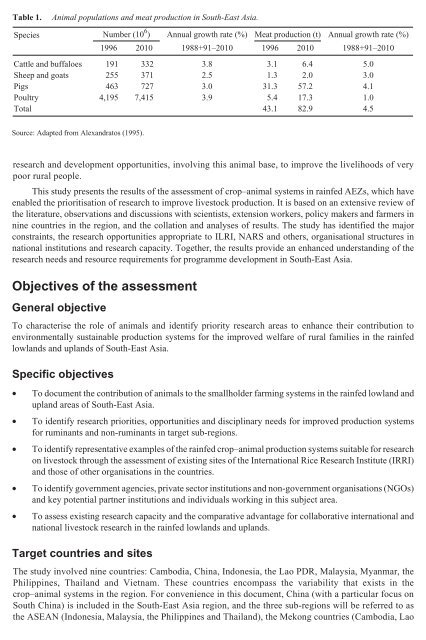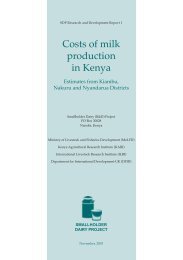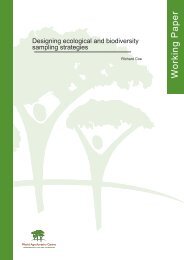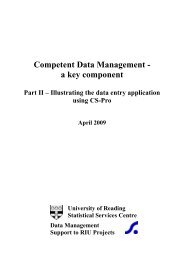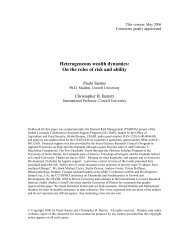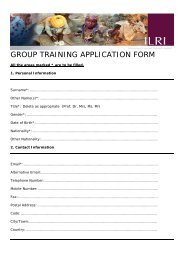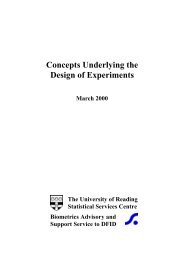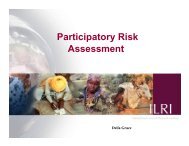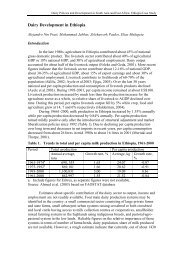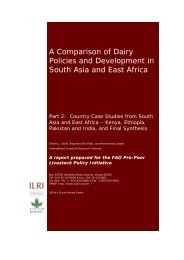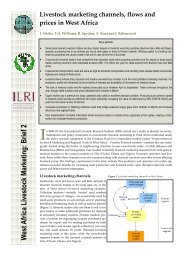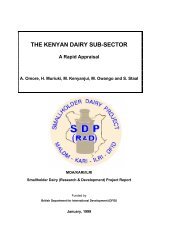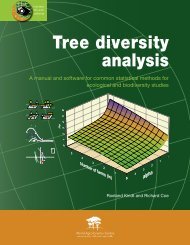1. BackgroundIntroductionThe International <strong>Livestock</strong> Research Institute (ILRI) has a global mandate to provide leadership <strong>in</strong> animalagriculture on behalf <strong>of</strong> the Consultative Group on International Agricultural Research (CGIAR). Thedef<strong>in</strong>ition <strong>of</strong> this global agenda <strong>in</strong>volves the development <strong>of</strong> appropriate research programmes for livestockimprovement <strong>in</strong> priority agro-ecological zones (AEZs). This task was facilitated by a regional consultationprocess, and identification <strong>of</strong> the requirements for livestock research <strong>in</strong> the different regions <strong>of</strong> Asia, Lat<strong>in</strong>America and the Caribbean, West Asia and North Africa, and sub-Saharan Africa (Gard<strong>in</strong>er and Devendra1995). In order to provide a sharper focus on the research priorities and programmes, ILRI proposed a detailedassessment <strong>of</strong> the research and development needs that would lead to the formulation <strong>of</strong> proposals forlivestock improvement <strong>in</strong> South-East Asia (Devendra and Gard<strong>in</strong>er 1995). This would also help to establishl<strong>in</strong>kages with the national agricultural research systems (NARS), and identify the comparative advantages<strong>of</strong> each to address priority researchable issues that are major constra<strong>in</strong>ts to livestock improvement <strong>in</strong>crop–animal systems. This assessment complements a broader study by ILRI and the Australian Centre forInternational Agricultural Research (ACIAR) on livestock trends and research options for animal agriculture<strong>in</strong> Asia.The sett<strong>in</strong>gThe South-East Asian region has achieved spectacular economic growth, with <strong>in</strong>creases <strong>in</strong> gross domesticproduct (GDP) <strong>of</strong> 4–9% over the last few years. The region has seen political maturity <strong>in</strong> the ASEAN, andan improvement <strong>in</strong> political stability <strong>in</strong> the Mekong countries. Agriculture is a major contributor to total GDP,and 43–88% <strong>of</strong> the human population <strong>in</strong> the region depend on this sector for their livelihood. <strong>Livestock</strong> <strong>in</strong>the <strong>in</strong>dividual countries contributes 6–20% to agricultural GDP, and play an important and variedsocio-economic role. In the Mekong countries and Ch<strong>in</strong>a there has been a shift from centrally planned toopen-market economies.About 95% <strong>of</strong> the domestic animals <strong>in</strong> South-East Asia are found on small resource-poor farms <strong>in</strong> ra<strong>in</strong>fedareas, where they are associated with cropp<strong>in</strong>g. Table 1 shows the animal populations <strong>in</strong> South-East Asia.Significant numbers <strong>of</strong> rum<strong>in</strong>ants and non-rum<strong>in</strong>ants are kept <strong>in</strong> the region. Buffaloes, ma<strong>in</strong>ly <strong>of</strong> the swamptype, are found <strong>in</strong> the rice-grow<strong>in</strong>g areas and are used for draft purposes and meat production. Cattle arema<strong>in</strong>ly dual-purpose, produc<strong>in</strong>g both meat and milk. Goats are more widespread than sheep throughout theregion. Amongst non-rum<strong>in</strong>ants, the populations <strong>of</strong> chicken are the largest followed by those <strong>of</strong> ducks andpigs. Commercial production systems for non-rum<strong>in</strong>ants are efficient, <strong>in</strong>tensive operations that are associatedwith the successful transfer <strong>of</strong> developed-country technology. These systems rely on purchased feeds,improved breeds, disease control and good market opportunities. Ducks, however, rema<strong>in</strong> to be developedmore <strong>in</strong>tensively. Chicken have recorded the highest average annual growth rates <strong>in</strong> recent years. All otherspecies, with the exception <strong>of</strong> buffaloes, recorded annual growth rates <strong>of</strong> 2.5–4.3% (FAO 1994a).Ris<strong>in</strong>g human populations and <strong>in</strong>come-driven changes <strong>in</strong> food habits will necessitate a two- to three-fold<strong>in</strong>crease <strong>in</strong> the supplies <strong>of</strong> meat, milk and eggs by the year 2010 (Table 1). In response to the <strong>in</strong>creaseddemand, animal numbers and output are projected to grow at a rapid rate. This will create competition withcrop production for resources such as land and labour, given that farms are already very small. Intensification,specialisation and greater susta<strong>in</strong>ability <strong>of</strong> animal production systems <strong>in</strong> a chang<strong>in</strong>g socio-economicenvironment are anticipated <strong>in</strong> the future.Agriculture has tended to emphasise crop production, notably rice, based on high <strong>in</strong>puts and <strong>in</strong>tensivesystems, result<strong>in</strong>g <strong>in</strong> enormous benefits through the ‘Green Revolution’. The focus has been ma<strong>in</strong>ly onthe over-populated irrigated areas which are experienc<strong>in</strong>g decl<strong>in</strong><strong>in</strong>g yields. To further <strong>in</strong>crease foodproduction attention must now be given to the neglected ra<strong>in</strong>fed lowland and upland AEZs, justifiedfurther by the relatively large human and animal populations <strong>in</strong> these areas. There are considerable
Table 1.<strong>Animal</strong> populations and meat production <strong>in</strong> South-East Asia.Species Number (10 6 ) Annual growth rate (%) Meat production (t) Annual growth rate (%)1996 2010 1988+91–2010 1996 2010 1988+91–2010Cattle and buffaloes 191 332 3.8 3.1 6.4 5.0Sheep and goats 255 371 2.5 1.3 2.0 3.0Pigs 463 727 3.0 31.3 57.2 4.1Poultry 4,195 7,415 3.9 5.4 17.3 1.0Total 43.1 82.9 4.5Source: Adapted from Alexandratos (1995).research and development opportunities, <strong>in</strong>volv<strong>in</strong>g this animal base, to improve the livelihoods <strong>of</strong> verypoor rural people.This study presents the results <strong>of</strong> the assessment <strong>of</strong> crop–animal systems <strong>in</strong> ra<strong>in</strong>fed AEZs, which haveenabled the prioritisation <strong>of</strong> research to improve livestock production. It is based on an extensive review <strong>of</strong>the literature, observations and discussions with scientists, extension workers, policy makers and farmers <strong>in</strong>n<strong>in</strong>e countries <strong>in</strong> the region, and the collation and analyses <strong>of</strong> results. The study has identified the majorconstra<strong>in</strong>ts, the research opportunities appropriate to ILRI, NARS and others, organisational structures <strong>in</strong>national <strong>in</strong>stitutions and research capacity. Together, the results provide an enhanced understand<strong>in</strong>g <strong>of</strong> theresearch needs and resource requirements for programme development <strong>in</strong> South-East Asia.Objectives <strong>of</strong> the assessmentGeneral objectiveTo characterise the role <strong>of</strong> animals and identify priority research areas to enhance their contribution toenvironmentally susta<strong>in</strong>able production systems for the improved welfare <strong>of</strong> rural families <strong>in</strong> the ra<strong>in</strong>fedlowlands and uplands <strong>of</strong> South-East Asia.Specific objectives• To document the contribution <strong>of</strong> animals to the smallholder farm<strong>in</strong>g systems <strong>in</strong> the ra<strong>in</strong>fed lowland andupland areas <strong>of</strong> South-East Asia.• To identify research priorities, opportunities and discipl<strong>in</strong>ary needs for improved production systemsfor rum<strong>in</strong>ants and non-rum<strong>in</strong>ants <strong>in</strong> target sub-regions.• To identify representative examples <strong>of</strong> the ra<strong>in</strong>fed crop–animal production systems suitable for researchon livestock through the assessment <strong>of</strong> exist<strong>in</strong>g sites <strong>of</strong> the International Rice Research Institute (IRRI)and those <strong>of</strong> other organisations <strong>in</strong> the countries.• To identify government agencies, private sector <strong>in</strong>stitutions and non-government organisations (NGOs)and key potential partner <strong>in</strong>stitutions and <strong>in</strong>dividuals work<strong>in</strong>g <strong>in</strong> this subject area.• To assess exist<strong>in</strong>g research capacity and the comparative advantage for collaborative <strong>in</strong>ternational andnational livestock research <strong>in</strong> the ra<strong>in</strong>fed lowlands and uplands.Target countries and sitesThe study <strong>in</strong>volved n<strong>in</strong>e countries: Cambodia, Ch<strong>in</strong>a, Indonesia, the Lao PDR, Malaysia, Myanmar, thePhilipp<strong>in</strong>es, Thailand and Vietnam. These countries encompass the variability that exists <strong>in</strong> thecrop–animal systems <strong>in</strong> the region. For convenience <strong>in</strong> this document, Ch<strong>in</strong>a (with a particular focus onSouth Ch<strong>in</strong>a) is <strong>in</strong>cluded <strong>in</strong> the South-East Asia region, and the three sub-regions will be referred to asthe ASEAN (Indonesia, Malaysia, the Philipp<strong>in</strong>es and Thailand), the Mekong countries (Cambodia, Lao
- Page 2 and 3: Affiliation of Authors:Dr C. Devend
- Page 4 and 5: 6.Strategyfor researchJustification
- Page 7 and 8: AcknowledgementsThe International L
- Page 9: esearch opportunities appropriate t
- Page 13 and 14: Introduction2. Characterisation and
- Page 15 and 16: Figure 2. Sub-humid tropics and sub
- Page 17 and 18: Table 3.Human and animal population
- Page 19 and 20: Table 5. Rice-growing environments
- Page 21 and 22: Multiple upland annual crop systems
- Page 23 and 24: Table 6. Continued.Country Importan
- Page 25 and 26: It should be noted that, compared w
- Page 27 and 28: Table 8.CountryCambodiaChinaIndones
- Page 29 and 30: of non-renewable fossil fuels and t
- Page 31 and 32: Overview of researchThere was a sur
- Page 33 and 34: • Identification of alternative c
- Page 35 and 36: Various animal production systems t
- Page 37 and 38: Presently, much of the vegetable pr
- Page 39 and 40: Table 10. Summary of the main socio
- Page 41 and 42: Table 11. Institutions and organisa
- Page 43 and 44: 3. In the ASEAN sub-region, inadequ
- Page 45 and 46: Table 12. Continued.SituationsPract
- Page 47 and 48: 6. Strategy for researchJustificati
- Page 49 and 50: Table 13. Priorities for research a
- Page 51 and 52: VietnamResearch capacity in NARS is
- Page 53 and 54: CRIFC (Central Research Institute f
- Page 55 and 56: IAS. 1995. Proceedings of the Works
- Page 57 and 58: Systems of sub-Saharan Africa. Volu
- Page 59 and 60: or waterlogged in the wet season an
- Page 61 and 62:
Table A1. Important diseases of ani
- Page 63 and 64:
• Increased cropping intensities,
- Page 65 and 66:
the animal output came from pigs al
- Page 67 and 68:
18-21° North, with an average rain
- Page 69 and 70:
In the Nusa Tenggara islands, signi
- Page 71 and 72:
Women work 11.5 h/day on average co
- Page 73 and 74:
Various Australian forage projects
- Page 75 and 76:
village production systems; to stud
- Page 77 and 78:
The availability of feed in rubber
- Page 79 and 80:
of the Ayeyarwady and Sittang river
- Page 81 and 82:
Constraints and opportunitiesInadeq
- Page 83 and 84:
gaining in importance, and signific
- Page 85 and 86:
Table A3. Characterisation of crop-
- Page 87 and 88:
Table A4. Interventions in crop-ani
- Page 89 and 90:
Table A4. Continued.Project TitleGo
- Page 91 and 92:
otations are practised, and there a
- Page 93 and 94:
such as abortion. Vaccination cover
- Page 95 and 96:
large areas of forests (3.4 million
- Page 97 and 98:
Table A6. Some animal diseases repo
- Page 99 and 100:
Appendix IIItineraryThe Philippines
- Page 101 and 102:
26 November 1996 am Visit to small
- Page 103 and 104:
Appendix IIIList of persons metPhil
- Page 105 and 106:
Mr Chhiv Nan, Acting Director, Depa
- Page 107 and 108:
Dr U Maung Ngint, Managing Director
- Page 109:
List of acronymsAARDACIARADBAEZAIBP


